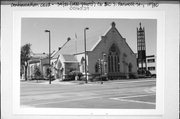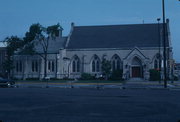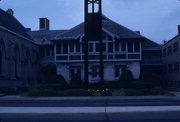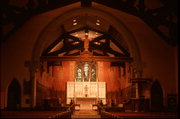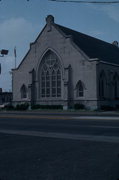Property Record
510 S FARWELL ST
Architecture and History Inventory
| Historic Name: | Christ Church Cathedral and Parish House |
|---|---|
| Other Name: | Christ Church Cathedral and Parish House |
| Contributing: | |
| Reference Number: | 16539 |
| Location (Address): | 510 S FARWELL ST |
|---|---|
| County: | Eau Claire |
| City: | Eau Claire |
| Township/Village: | |
| Unincorporated Community: | |
| Town: | |
| Range: | |
| Direction: | |
| Section: | |
| Quarter Section: | |
| Quarter/Quarter Section: |
| Year Built: | 1910 |
|---|---|
| Additions: | 1935 1915 |
| Survey Date: | 1997 |
| Historic Use: | house of worship |
| Architectural Style: | Late Gothic Revival |
| Structural System: | |
| Wall Material: | Limestone |
| Architect: | Purcell, Feick & Elmslie; Armstrong, Furst & Tilton |
| Other Buildings On Site: | |
| Demolished?: | No |
| Demolished Date: |
| National/State Register Listing Name: | Christ Church Cathedral and Parish House |
|---|---|
| National Register Listing Date: | 1/28/1983 |
| State Register Listing Date: | 1/1/1989 |
| National Register Multiple Property Name: | Multiple Resources of Eau Claire |
| Additional Information: | Christ Church Cathedral occupies a prominent corner location within Eau Claire's central business area. The buff Bedford stone church is a rectangular structure covered by a broad slate-covered gable roof. The nave, constructed five years after the chancel which forms the westernmost section of the composition, is taller than the chancel and is distinguished by prominent shouldered end walls. Crosses mark the gable peaks. Oriented east-west, the building is identified by a number of lancet openings, which in most cases, encompass additional lancet divisions. The most significant of these windows is that known as the Nativity window located on the east facade (facing S. Farwell Street). The large pointed arch frame includes four narrow lancet windows paired beneath two small round windows. A larger round window crowns the design. To either side of the opening are buttresses and small lancet windows defined by pronounced drip molds. On the south side of the church is the main entrance contained within a gabled projection. The position of the entrance allowed for the placement of the east window described above. A compound pointed arch portal frames the double door entrance that features a Latin cross design. The arches rest on slim marble columns with foliated capitals. Blocks of quatre-foil decoration and two small lancet windows on either side wall further ornament the entrance area. Also located on the south facade are three lancet windows composed of paired lancet openings surmounted by a round window characterized by a trefoil design. Buttresses separate the two windows located west of the entrance. Similar openings, four in number and also separated by buttresses, mark the north facade. The west facade, or the west wall of the chancel, is distinguished by another large lancet opening that lights the altar area. The Resurrection window contains three lancet divisions crowned by three round openings enclosing trefoil patterns. At the southwest corner of the nave and chancel is the Chapel of the Ascension, a small rectangular addition (1935) covered by a slightly sloping roof and bounded by parapet end walls. The chapel continues the Gothic elements of its adjoining structures. The stone walls are pierced by paired lancet windows set within rectangular frames. Buttresses separating the three pairs are also present. At the chapel's west end is a rose window featuring again the trefoil design. The addition of the chapel obscured the clerestory windows which originally lined the upper portion of the south wall of the chancel. The church's interior is also distinguished. Impressive scissor trusses (original feature) support the roof of the structure. Dividing the nave from the chancel is a magnificent roof beam surmounted by the figure of Christ looking down from the cross. It was executed by one of the Oberammergau Langs and presented to the congregation in 1927. The sanctuary contains the Carrara marble altar and reredos that were in place in 1910. The choir area which has been altared contains three rows of pews on each side of the center axis of the church. The pews and the finely carved wainscoting that faces the walls of the sanctuary are of Appalachian oak. Generally, the woodwork throughout the rest of the church is Wisconsin-grown oak and maple. As recorded in a church pamphlet, "the Cathedral windows are the glory of Christ Church. Of English design an execution, they are among some of the finest in the country in richness and ecclesiastical style" (B). Six of the windows, including the Resurrection and Nativity windows, were designed by Heaton, Butler, and Bayne of London. The Wippell Company of Exeter, England, provided the remaining windows. Attached to the chancel on the north and constructed at the same time, the parish house is a two and a half story stone and stucco building capped by a hip roof with a gablet at the peak. The second story of the structure just over the first story and is further differentiated by its stucco and decorative half timbered walls. A center gable interrupts the roof line and covers an opening composed of three rectangular windows capped by smaller square windows. These windows, diamond-paned like all those included in the building, are repeated beneath the gables on the north facade. Paired rectangular windows also mark the upper story of the main facade. Below, on the ground level, the smooth ashlar walls are pierced by three pairs of recessed openings identified by prominent sills. These windows contain the crests which document the history of the Episcopalian faith. Extending from the center portion of the parish house are wings that reach to the south, attaching the parish house to the chancel, and to the north. The southern extension contains the main entrance below a gabled hood supported by braces. The double doors of the entry feature the outlines of the Latin cross in wood and glass. On the interior, the second story of the parish house is characterized by the same scissor truss support system that was used in the nave of the church. The first floor was extensively altered in 1965. Christ Church Cathedral, designed by the distinguished Minneapolis architectural firm of Purcell, Feick and Elmslie (Purcell and Feick were primarily responsible for the chancel and the parish house), is an architecturally significant resource in Eau Claire, providing an excellent example of early twentieth century Neo-Gothic church design. The smooth stone structure with its prominent lancet openings reflects the architects' use of English antecedents in the manner of the Arts and Crafts movement. In the words of William Purcell himself - "In all the study, there was a sincere effort to try to reproduce in myself the mental attitude with which a master mason architect of 1150 would have come to such a problem" (E). The design, too, furnishes another aspect of the architects' career for in this instance their more "radical" predelictions were surpressed in the face of the desires of a conservative and traditionally-minded congregation. The adjoining parish house, constructed with the church chancel in 1910, is likewise architecturally significant, continuing the medieval flavor of the church structure. The parish house is reported to have been patterned after Benham Abbey in Norfolkshire, England (D). The architectural firm of Purcell, Feick and Elmslie had its beginnings in 1906 when William Gray Purcell and George Feick joined together in an office in Minneapolis. Three years later George Grant Elmslie was added, establishing the prominent Midwest partnership whose practice exceeded even that of Frank Lloyd Wright. In Eau Claire the firm was also responsible for the J.D.R. Steven home (1909; NRHP 1982), the Community House of the First Congregational Church (1914; NRHP 1974), and a bungalow and church parsonage which have been substantially altered. The original plans for the Christ Church Cathedral Parish House and chancel (the product of the Purcell and Feick office) were drawn in 1908. (These are available at the Northwest Architectural Archives in Minneapolis.) The buildings were then constructed in 1909-1910. Attached to the chancel was the old church building which originally stood on the parish house site. In May 1915 the frame church building was dismantled and construction of the nave, the design of Purcell, Feick and Elmslie in May, 1920 (D). Another addition, a chapel erected in 1935 with funds donated by a church member, was built at the southwest corner of the building. Designed by the Chicago firm, Armstrong, Furst & Tilton, the Chapel of the Ascension is a fine, compatble continuation of the church structure. The Episcopalian congregation in Eau Claire was formed in the mid-1850's as the community began its prosperous lumber era. The first services were held in 1858, but not until after the Civil War were these regular and well-attended. A frame church structure, located on the site now occupied by the parish house, was begun in 1873 and completed in 1875. In 1904 a lot adjacent to the church was purchased and in 1908 plans for the construction of a parish house and chancel were presented to and approved by the congregation. Later in the twentieth century, the diocese of Eau Claire was established and in 1931 Christ Church was designated the Cathedral (D,F). 2016- "Eau Claire's Episcopalians organized a congregation in the mid-1850s and first held a service in 1858. A frame church structure was completed on this site in 1875. In 1910, the present chancel and parish house were built adjacent to this original structure. Five years later, the frame church was dismantled and the present church nave was built. After the establishment of the diocese of Eau Claire, Christ Church was designated a cathedral in 1931. Both the Cathedral and Parish House were the work of Purcell, Feick, and Elmslie, a prominent Minneapolis firm which designed churches, residences, and public buildings in California, Connecticut, Massachusetts and the Midwest Perhaps its best-known public building is the Merchants National Bank in Winona." -"Eau Claire Landmarks: Designated Historic Properties in Eau Claire, Wisconsin", Eau Claire Landmarks Commission, P.O. Box 5148, 2016. |
|---|---|
| Bibliographic References: | (A) Building inscription. (B) A Journey Through Christ Church Cathedral, 1978. Church pamphlet available at Chippewa Valley Museum. (C) Original plans located in church library; some plans for church also available at Northwest Architectural Archives, University of Minnesota. (D) History of Christ Church Cathedral, 1958, p. 31. (E) Gebhard, D. 1957. "William Gray Purcell and George Grant Elmslie and the Early Progressive Movement in American Architecture from 1900 to 1920." PhD. University of Minnesota, p. 117. (F) History of Eau Claire County, 1914, pp. 525-531. (G) The Parish House was built in 1909, by Purcell, Feick and Elmslie. (H) Another map code for this building is EC 1P/30, with a corresponding Survey Map name of Plat Map # 8. Take a Walk on Main Street: Historic Walking Tours in Wisconsin's Main Street Communities, Wisconsin Main Street Program, 1998. Eau Claire Landmarks booklet published by the Eau Claire Landmarks Commission in 2002. |
| Wisconsin Architecture and History Inventory, State Historic Preservation Office, Wisconsin Historical Society, Madison, Wisconsin |

